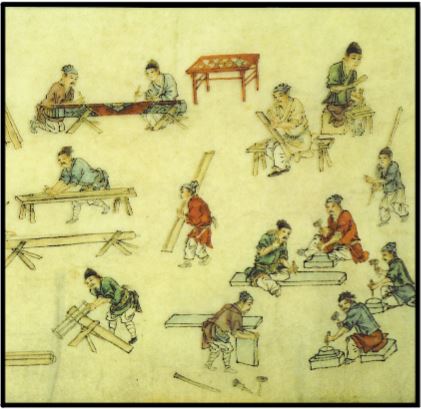China Han Dynasty Biography Activity
#1 Artisans

Artisans, or craftspeople, were one of several groups in Han society that made up the class of commoners. As a group, artisans earned more money than farmers, but not as much as merchants. Although artisans did not enjoy the high social status of nobles or officials, they were well respected in Han society.
The artisans of the Han empire included painters, jewelers, weavers, potters, carpenters, and metal workers. Many worked in government-owned factories and workshops under strict supervision. Others worked in private workshops that produced goods for the wealthy.
Metalworkers were responsible for some important developments during the Han period. Prior to the Han dynasty, metalworkers shaped iron by hammering it while it was red hot. Han metal workers, however, learned how to pour molten iron into clay molds to cool. Many scholars believe this was the first time in history in which a cast-iron process was used. Han metalworkers also learned to make steel by heating cast-iron until most of the carbon was gone. Using these techniques, they were able to produce agricultural tools, cooking pots, various everyday objects such as scissors, and weapons of very high quality.
Another group of artisans were skilled weavers who worked with silk. Those who sewed elaborate patterns into the silk were known as embroiderers. These silk craftspeople, most of whom were women, were highly valued because silk was an important product in ancient China. Many clothes for wealthy people were made of silk, including imperial robes. In addition, important paintings were sometimes done on silk, and silk was used as a writing material for special occasions. Because silk was so valuable, high officials were sometimes paid in silk. They received rolls, or bolts, of the material as payment for their work. Silk also became ancient China’s most popular trade good. Traders and merchants exchanged China’s silk for goods such as gold and glassware from such faraway places as Rome and Syria.
Other skilled artisans worked with lacquer. Lacquer was a substance made from the natural sap of a tree. It was used as a protective coating and decoration on a variety of everyday items. These items included tableware, furniture, shoes, weapons, and even coffins. Some of these objects were made of wood and the lacquer was brushed onto the surface, like paint. Craftspeople lacquered many objects with decorations in black or red colors, and they highlighted them with precious metals such as gold, silver, and bronze. It took fine workmanship and many long hours to create these objects. Many of them became high-priced luxury items that were supplied to the imperial court and the households of nobles and high officials.
The artisans of the Han empire included painters, jewelers, weavers, potters, carpenters, and metal workers. Many worked in government-owned factories and workshops under strict supervision. Others worked in private workshops that produced goods for the wealthy.
Metalworkers were responsible for some important developments during the Han period. Prior to the Han dynasty, metalworkers shaped iron by hammering it while it was red hot. Han metal workers, however, learned how to pour molten iron into clay molds to cool. Many scholars believe this was the first time in history in which a cast-iron process was used. Han metalworkers also learned to make steel by heating cast-iron until most of the carbon was gone. Using these techniques, they were able to produce agricultural tools, cooking pots, various everyday objects such as scissors, and weapons of very high quality.
Another group of artisans were skilled weavers who worked with silk. Those who sewed elaborate patterns into the silk were known as embroiderers. These silk craftspeople, most of whom were women, were highly valued because silk was an important product in ancient China. Many clothes for wealthy people were made of silk, including imperial robes. In addition, important paintings were sometimes done on silk, and silk was used as a writing material for special occasions. Because silk was so valuable, high officials were sometimes paid in silk. They received rolls, or bolts, of the material as payment for their work. Silk also became ancient China’s most popular trade good. Traders and merchants exchanged China’s silk for goods such as gold and glassware from such faraway places as Rome and Syria.
Other skilled artisans worked with lacquer. Lacquer was a substance made from the natural sap of a tree. It was used as a protective coating and decoration on a variety of everyday items. These items included tableware, furniture, shoes, weapons, and even coffins. Some of these objects were made of wood and the lacquer was brushed onto the surface, like paint. Craftspeople lacquered many objects with decorations in black or red colors, and they highlighted them with precious metals such as gold, silver, and bronze. It took fine workmanship and many long hours to create these objects. Many of them became high-priced luxury items that were supplied to the imperial court and the households of nobles and high officials.
